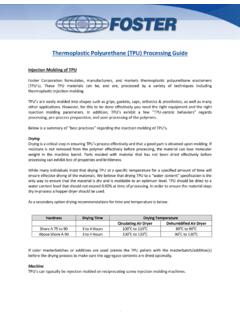Transcription of Extrusion Guide - Foster Corporation
1 Links Science to Life Lubrizol LifeScience PolymersExtrusion Guide1 Extrusion Guide IntroductionLifeScience Polymers (LSP) is a business within The Lubrizol Corporation that provides innovative polymer solutions for healthcare products. Among the chemical technologies employed by LSP are thermoplastic polyurethane elastomers (TPUs). The LSP TPUs are grouped into several families of products with varying chemical and physical characteristics. They can be readily converted to flexible, elastic forms such as tubing and film on conventional thermoplastic Extrusion brochure is intended to provide general guidelines for equipment, procedures and Extrusion conditions that will help the customer obtain the best possible performance from the LSP line of TPU Extrusion grades. Additional information can be obtained by consulting individual product Technical Data Sheets or by contacting your Lubrizol LSP technical service or sales The LSP TPUs are available in both aromatic and aliphatic types.
2 The choice of polyol raw material during manufacture leads to the families of polyester, polyether and polycarbonate grades. Separate LSP literature is available describing detailed properties of the various classes and grades. All of these TPU types have common characteristics as far as Extrusion processing behavior and practices. This Guide covers those general CrystallinityTPUs are generally not considered to be crystalline polymers that would be represented by a product like low-density polyethylene (PE). Some of the harder TPU grades (~> 90 Shore A) could be considered semicrystalline. Softer grades (~62A 85A) can be nearly amorphous they have no definite melting point but soften gradually on heating. Upon heating and shear mixing within an extruder, they achieve a viscous fluid state characteristic of a polymer much like low-density polyethylene.
3 Melt viscosities suitable for Extrusion will be achieved at temperatures well below the point of degradation. Initial softening points range from 250 F 340 F (121 C 171 C) while melt temperatures suitable for processing will be generally about 20 C grades will require higher temperatures to achieve a homogenous melt. They will also have a narrower processing temperature range in which the melt viscosity is suitable for forming extrudate profiles. This behavior is a consequence of the degree of crystallinity of the TPU; in general, harder TPUs have higher crystallinity and require more heat/shear to identified as injection molding grades generally are harder (~> 50D) and have this narrow processing range. Molding grades are usually not suitable for are some hard (~> 50D) TPU Extrusion grades.
4 Greater diligence in the processing operation is required. For example, slow-moving materials can solidify within the extruder by an annealing process. Cloudy particles in the extrudate can indicate sloughing of annealed conditions specific to individual grades can be found in the product Technical Data Processing TemperatureTemperatures in excess of 450 F (232 C) may result in polymer degradation as evidenced by bubble formation within the TPU melt. If this occurs, a reduction in zone temperatures will restore bubble-free extrudate and stabilize Extrusion conditions. Generally, temperatures near this maximum result in melt viscosities that are too fluid to maintain a viable form (tube, film, etc.) when exiting the ViscosityA key TPU variable critical to Extrusion processing is the molecular weight.
5 This is directly related to the length of the polymer chain. This variable governs the melt viscosity achieved by the material in an Extrusion process; higher molecular weights create higher melt viscosities, which in turn have higher melt strengths when measured at the same temperature. Of course, melt strength determines how easily a melt can be handled to form a rod, a tube, a film, :IntroductionMaterialsTPU CrystallinityMaximum Processing TemperatureMelt ViscosityBasic Guidelines/EquipmentCommon Extrusion Issues Polyurethane Films Cast Film and Sheet ExtrusionEquipment Extrusion Coating/Equipment Blown Film Wire & Cable Coating, Hose Jacketing/Equipment Tubing and Profile Extrusion /Equipment Troubleshooting Guide 1 1 1 1 12 4 4 455 6 7 8102 Lubrizol TPU business has determined that the TPU molecular weight, melt viscosity, etc.
6 , can be correlated to the melt index (MI) of the material. The relationship of melt viscosity to melt index is inverse: higher molecular weight, higher viscosity TPUs have lower MIs. Conversely, lower molecular weight, lower melt viscosity TPUs have higher MIs. With years of experience and hundreds of customer experiences, Lubrizol has determined the optimal melt index range that is suitable for each product and the Extrusion process that would be used. For example, TPUs designed for fabric coating generally require lower melt viscosity (higher MI); the lower viscosity provides a fluid melt to level out. The fabric provides support for the lower viscosity. Conversely, TPUs intended for tubing may have higher melt viscosities (lower MI) to better maintain the unsupported index is routinely determined for nearly all LSP TPU grades.
7 In comparing the MI of one TPU grade to another, it is critical that the MIs of both materials be carried out under the same conditions of temperature and load. Although 190 C/8700 grams is a common TPU MI condition, there are many other combinations of individual MI value on a single box, bag or lot of TPU is generally of importance as it relates to prior experience with the product. Small changes to the Extrusion process may be required if the MI is different. Customers extruding large quantities of TPU continuously may stage their pallets of material by MI. Generally, it is better to run high MIs (lower viscosity) followed by low MIs (higher viscosity).Blending of TPU pellets to achieve a different set of properties is generally not recommended. Mixing an 80A TPU with an 85A TPU will achieve an intermediate hardness TPU extrudate, provided that the materials successfully melt blend in the extruder.
8 Achieving a uniform melt in a single-screw extruder can be difficult with a mixture of soft and hard TPU pellets. In addition to the difference in hardness, the TPUs may also vary in melt viscosity (MI), as similar melt uniformity concern occurs when regrind is used. Depending on the Extrusion conditions at the time the regrind product was created, the MI may be very different than virgin resin. The shearing process can break polymer chains, resulting in a lower-viscosity (higher-MI) material. When this is mixed with lower-MI virgin resin, achieving a uniform melt may require significant adjustments to the process. The worst combinations to process are low percentages of low MI mixed with high percentages of high MI. Knowing the MI of regrind may be GuidelinesLSP TPUs must be properly dried before processing.
9 There are no grades which can be reliably extruded without drying. Although LSP TPUs have low moisture content when manufactured, TPUs are hygroscopic (absorb and retain water from the air). Subsequent handling, transportation and storage conditions can increase the moisture content. Inadequate drying can result in a loss of properties of the extruded product and may give a poor appearance. Extruder barrel and die temperatures must be set properly for each product. Deviation from the recommendations may result in poor Extrusion quality. These recommendations can be found on the Technical Data Sheet. The rate of Extrusion has a large impact on the quality of the product and should be adjusted in general can be tacky during processing, so rollers should be coated with suitable nonstick materials.
10 Many LSP TPU compounds are already formulated to reduce blocking and tackiness. However, the addition of a lubricant masterbatch may be necessary to assure good processing. If a masterbatch or regrind/recycle is added to virgin TPU, then these materials must also be properly dried and may have a significant impact on the quality of the product. TPUs do not draw down well compared to other thermoplastics like polyethylene; therefore, drawdown should be minimized in the process. It is not recommended to shut a line down on TPUs. Even during short breaks, material should be kept moving at slow rates through the system. This is particularly critical for the hard grades, which may undergo an annealing process within the extruder and become more crystalline, and in excessively long stagnant downtimes, can Hopper DryerIt is imperative to dry the material immediately prior to Extrusion .







